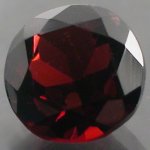We offer layaway, spread payments on the piece of your dreams. Ask us for details. Free insured shipping on all orders !!!

Antique jewelry glossary
Welcome to our extensive antique jewelry glossary with around 1,500 jewelry related entries.If you feel you are missing an explanation, feel free to let us know and we will add it.
A - B - C - D - E - F - G - H - I - J - K - L - M - N - O - P - Q - R - S - T - U - V - W - X - Y - Z all
Almandine

See our: garnet jewelry.
A variety of garnet that is transparent and commonly deep crimson with tinges of purple. Its colour may resemble that of ruby. It is cut in several forms; when cut en cabochon (usually as hollow cabochon to lighten the colour), it is called carbuncle. Some stones are shaped in India by tumbling, and sometimes now are faceted.
The main sources are Sri Lanka (formerly Ceylon), Fort Wrangel in Alaska, and India. An alternative name is 'almandite'. A sub-variety has inclusions of needles) of foreign substances, which sometimes form a weak 4-pointed or 6-pointed star such stones are called 'star almandine'.
From: An Illustrated Dictionary of Jewelry, autor: Harold Newman, publishers: Thames and Hudson
Almandine
Almandine, also known incorrectly as almandite, is a species of mineral belonging to the garnet Group. The name is a corruption of alabandicus, which is the name applied by Pliny the Elder to a stone found or worked at Alabanda, a town in Caria in Asia Minor. Almandine is an iron alumina garnet, of deep red color, inclining to purple. It is frequently cut with a convex face, or en cabochon, and is then known as carbuncle. Viewed through the spectroscope in a strong light, it generally shows three characteristic absorption bands. Almandine is one end-member of a mineral solid solution series, with the other end member being the garnet pyrope. The almandine crystal formula is: Fe3Al2(SiO4)3. Magnesium substitutes for the iron with increasingly pyrope-rich composition.
Almandine occurs rather abundantly in the gem-gravels of Sri Lanka, whence it has sometimes been called Ceylon-ruby. When the color inclines to a violet tint, the stone is often called Syrian garnet, a name said to be taken from Syriam, an ancient town of Pegu. Large deposits of fine almandine-garnets were found, some years ago, in the Northern Territory of South Australia, and were at first taken for rubies and thus they were known in trade for some time afterwards as Australian rubies.
Almandine is widely distributed. Fine rhombic dodecahedra occur in the schistose rocks of the Zillertal, in Tyrol, and are sometimes cut and polished. An almandine in which the ferrous oxide is replaced partly by magnesia is found at Luisenfeld in German East Africa. In the United States there are many localities which yield almandine. Fine crystals of almandine embedded in mica-schist occur near Fort Wrangell in Alaska. The coarse varieties of almandine are often crushed for use as an abrasive agent.
From: Wikipedia









